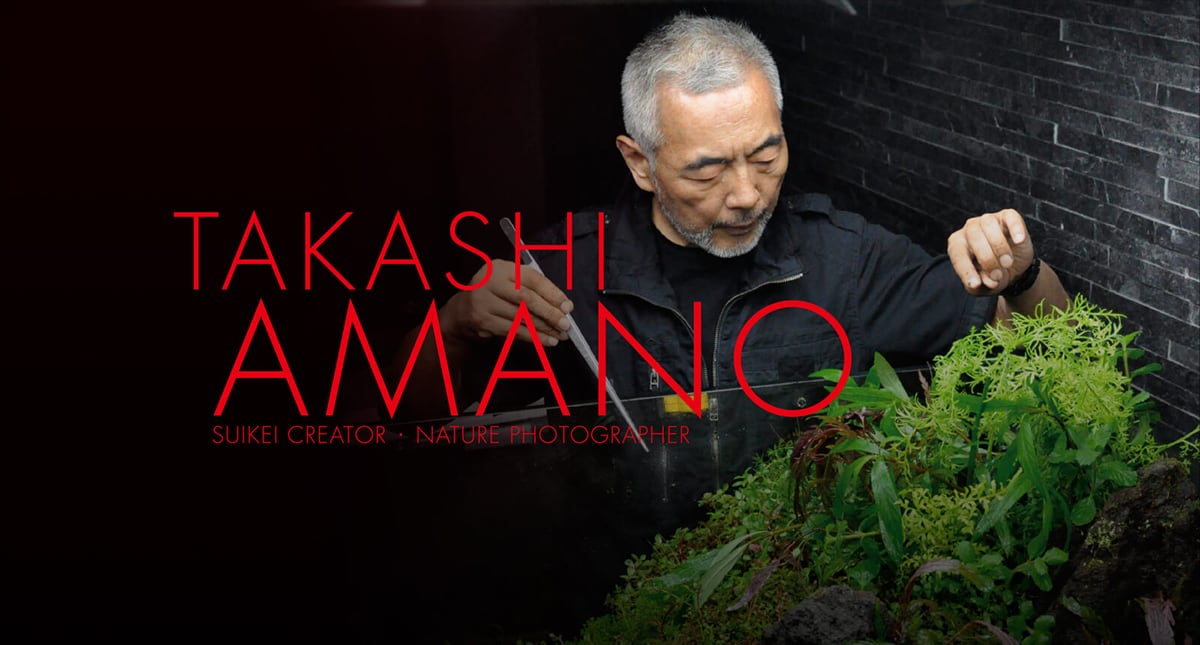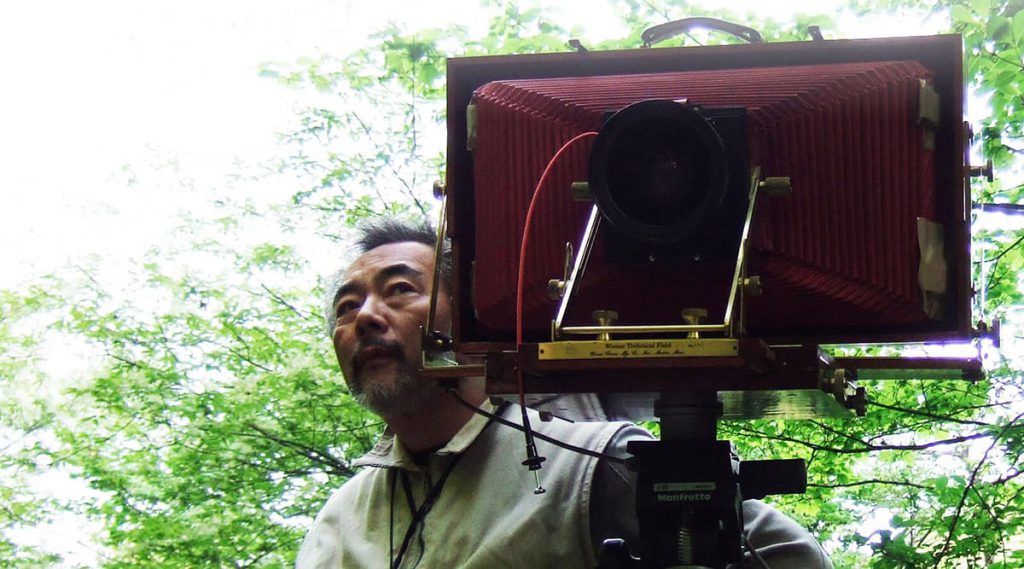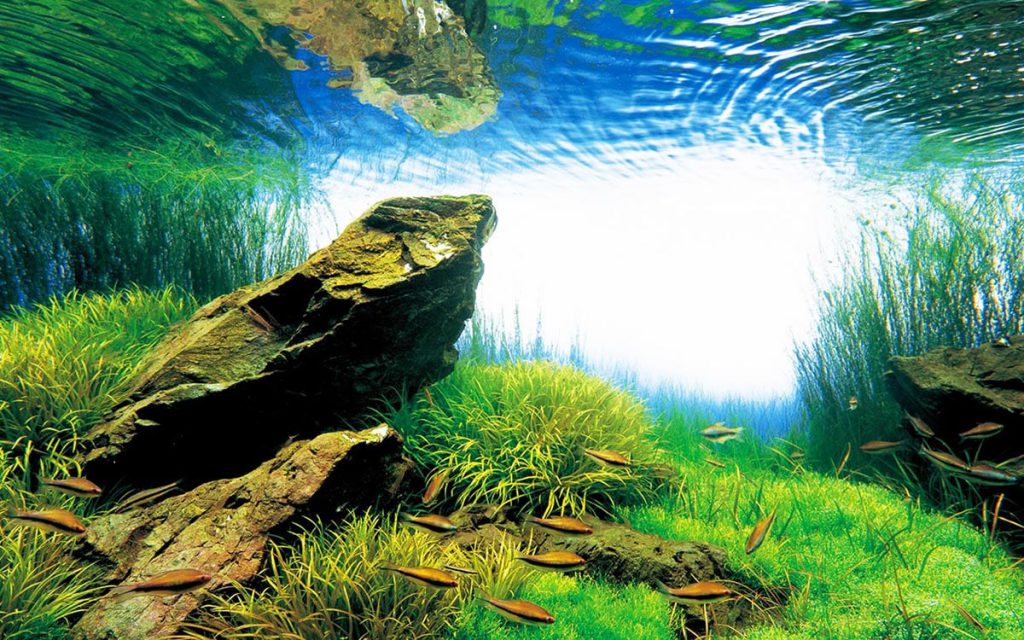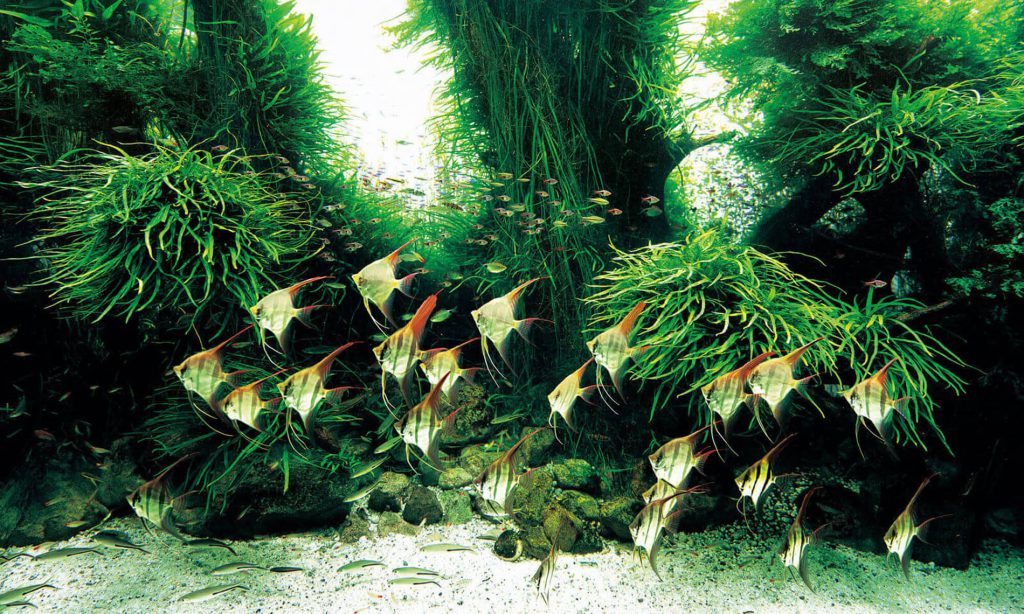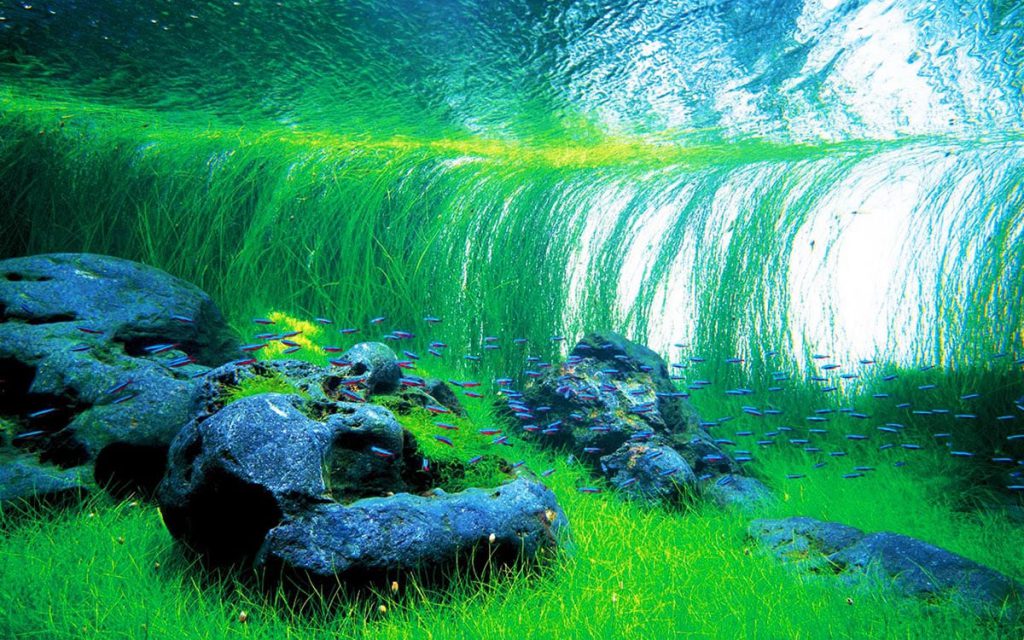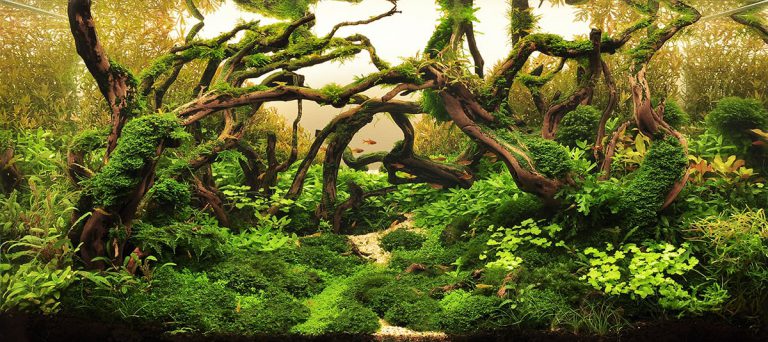Born on 18th July 1954 in Niigata, Japan, Takashi Amano, the creator of the Nature Aquarium, is best known for his photography and aquascaping. Amano first found fame as a professional cyclist. He began competing in 1974 and retired from the sport in 1990. Amano competed in 1078 races and earned the staggering figure (in cycling) of in excess of £1,000,000…
His love of aquariums and planted tanks started in his teenage years and a considerable amount of his cycling earnings were spent on his joint hobbies of aquascaping and photography.
‘To know Mother Nature, is to love her smallest creations’
Takashi Amano
Takashi Amano – Nature Photographer and Author
In 1977, Amano made a breakthrough in the world of aquarium plant keeping: carbon dioxide injection. He experimented with carbonated water after noticing, while out drinking in a bar, bubbles in carbonated drinks.
When he added carbonated water to his tanks, he found that the bubbles appeared here too. What had Amano discovered? The reason that plants grew better in older tanks was that the set-ups were producing carbon dioxide, which the plants required for the photosynthesis process!
Aquarium planting would never be the same again; his breakthrough lead to the injection of carbon dioxide into planted tanks. Following his discovery, Takashi Amano spent the next 15 years refining his aquascaping. He concentrated on his layout techniques and his other great love, photography.
‘(Amano) is a portrait painter who uses an aquarium as his canvas’
Dr. Herbert R. Axelrod, 1992
Takashi Amano’s first major win on the photographic scene was in 1991 when he won the JPS Photography Contest. His image was selected for public exhibition.
In 1992, he achieved success in the Fujifilm Nature Photo Contest with his piece ‘Oniodori’, which depicted a submersed image of an Asian Wrasse.
Takashi showed his work at many exhibitions. The most notable include:
- Urin – Ujou, Japan, 1998
- Dare mo Shiranai Amazon, Japan, 2004
- The Rio Negro, Japan, 2004
- The Rio Negro, Japan, 2006
- Sozo no Genten Amazon, Japan, 2006
- Kusatsu – Amazon, Japan, 2006
- Sado – From bottom of the Sea to the Pristine Forest, Japan, 2007
- Daremo Shiranai Sado, Japan, 2007
- Daremo Shiranai Sado, Japan, 2008
- Sado – a Natural Treasure of Japan, Quatar, 2009
- Takashi Amano in India for Aquatika 2009, India, 2009
- Forests Underwater, Portugal, 2015
Amano loved large format photography and regularly had his own sheets made by Fuji for his precise film requirements. Large format usually uses 4×5 and 8×10, but Amano’s specialist photography demanded 8×20.
Avoiding modern techniques, such as digital photography, Takashi Amano found that film photography captured the colours and textures that he wanted to portray.
Photography took Takashi Amano all over the world. Some of his particularly noted work was taken in Borneo, Western Africa and the Amazon. His work was not just enjoyed in Japan, but around the world. In 2008, attended by some of the world’s most important leaders, Amano’s work was displayed at the G8 summit in Tokyo.
Takashi Amano was also a prolific author. His titles include:
- Glass no Naka no Daishizen, 1992
- Mizu – Shizen eno Kaiki, 1994
- Nature Aquarium World, 1994
- Pflanzenparadies unter Wasser, 1994
- Nature Aquarium World Book 2, 1996
- Nature Aquarium World Book 3, 1996
- De wonderlijke wereld onder water, 1996
- Faszinierendes Aquarium, 1996
- Le Nouveeau Monde des Plantes Aquatiques, 1996
- Aquarium Plant Paradises, 1997
- Amanos Naturaquarien, 1997
- Ihr Hobby-Naturaquarien, 1998
- Diskus im Naturaquarium, 1998
- Das Große Buch der Naturaquarien, 1998
- Les aquariums naturels d’Amano, 1998
- The Rio Negro, 2004
- Sado – To Pristine Forest From Bottom of Sea, 2007
- Sado – To Pristine Forest From Bottom of Sea “Revised and Enlarged Edition”, 2009
- Nature Aquarium: Complete Works 1985-2009, 2011
The Creation of the Nature Aquarium
Takashi Amano created a whole new way of arranging a planted tank. He combined Japanese gardening techniques, Wabi-sabi (a Japanese art style that seeks beauty in the imperfect, transient nature of objects), and Zen art.
This combination was given the name Nature Aquarium. The philosophy guiding his new term Nature Aquarium is that a complete ecosystem can only be one where plants and fish live in harmony and all of the species in the aquascape are living in their own perfect living environment.
The Amano Shrimp
During Takashi’s extensive work with freshwater tanks, he discovered that there was a species of shrimp that ate quantities of algae that others couldn’t match. This led him to order many thousands of them from his local distributor.
The Caridina multidentata (previously Caridina japonica) was then re-named after him, the Amano shrimp. Aquascapers have continued to add these shrimp to their tanks, so much so that they have since become a staple in the aquascaping world.
The Amano shrimp is also loved by aquascapers as it is considered to be a generally a non-aggressive shrimp, that does not harm any other aquarium inhabitants.
Takashi and Aqua Design Amano, Premium Aquascaping Tanks, Tools & Accessories
One of Amano’s lasting legacies is his company, Aqua Design Amano Co., Ltd. (ADA), which he founded in 1982. The company sells the highest quality aquatic plant growing equipment and has attracted much global attention.
The aquarium equipment brand ‘Nature Aquarium Goods’, are renowned for being of an excellent quality and design. ADA has succeeded in becoming the worlds’ most recognizable manufacturer and supplier of premium products to the aquascaping world.
Lisbon Nature Aquarium, Takashi’s Final Masterpiece
In 2013, Amano received an invite from the aquarium Oceanario de Lisboa in Portugal, one of the most renowned aquaria in Europe, to design and install the world’s largest Nature Aquarium. The challenge laid down was to create this aquascape of unprecedented scale within one week.
To achieve success with this project, Amano spent an extensive period of time planning and preparing for the feat. He had assistance from people he had trained in his methods and workings to support and work under his leadership for the project.
The grand opening ceremony was 21st April 2015, opening to the public on the following day. Critics acclaimed the Nature Aquarium as a masterpiece. It was a testament to Takashi Amano’s passion and creativity.
Tropical Paradise was the concept of this aquascape and displayed Takashi’s passion and understanding of the tropical forests. The delicate planting compromised aquatic plants that were placed as if they were in a tropical jungle.
Facts and figures of the ‘U’ shaped aquarium:
- 40m long
- 2.5m deep
- 1.5m water depth
- 160,000 litre/160t
- 4 tonnes of sand
- 25 tonnes of volcanic rock
- 8 tonnes of aquasoil
- 2 tonnes of wooden branches, including 78 giant pieces of driftwood
- More than 46 species of plant
- 10,000 tropical fish of 40 different species
This incredible work of art stands in a different league to his other work. It is clear for all to see that it was his most impressive piece of art in a long and devoted career.
“I expressed a miniature global environment in this massive aquascape by incorporating underwater views and biodiversity I have encountered in tropical rainforests in the world into this grand work … It would be my greatest pleasure if more people could have hearts to value nature through this aquascape.”
Takashi Amano
Amano’s Legacy
In 2015 at the age of 61, Takashi Amano died of pneumonia. His life work in photography and aquascaping completely revolutionised aquarium layouts and the thinking behind their designs.
His love of design, and inclusion of ideas such as natural products in Wabsi-sabi and Zen rock arrangements produced breath-taking natural aquariums. The minimalist application of Iwagumi and the concept of wabi-kusa are unlikely to have even come into existence if it wasn’t for Takashi Amano’s life-long passion.
The use of Nature Aquarium to describe a representation of a wilderness scene, was unseen and unheard of before his use of it.
It is not just hardscaping that Takashi Amano will be remembered for. His use of Riccia, Glossostigma, Hemianthus, and others greatly contributed to them becoming modern aquascaping staples.
Many in the aquascaping world are now referring to Takashi Amano as ‘master’ or ‘sensei’ out of respect for his commitment and genius in the field.
“Takashi Amano is almost single-handedly the reason I dearly love my work and hobby so much. I vividly remember the first moment I saw his work in Nature Aquarium World Book One and it was like an epiphany for me. I knew that’s what I wanted to achieve and it triggered my incredible journey into the world of aquascaping.
UK aquascaper, George Farmer
He changed my perception on aquariums, from glass boxes that keep fish, to works of art. I cannot thank him enough for the inspiration and joy he has helped bring into my life. I am so very sad that I never got to meet him and thank him in person.
The world has lost a brilliant artist but his work lives on through the countless aquascapers he has inspired.”
Art tells a story, and viewing Amano’s art from his ideal of a Nature Aquarium, you are immersed in their tales.
“They are so beautiful that they border on perfection, yet so simple and natural that you almost think that you are looking at some undisturbed pond out in the middle of a forest.”
Dabney, Okeanos Aquascaping
Enjoyed this article? Spread the word by sharing it with your friends!

